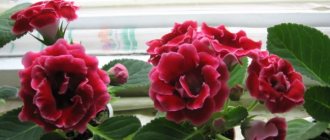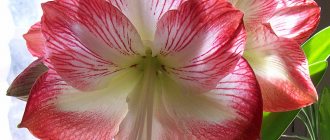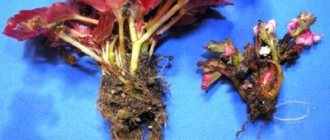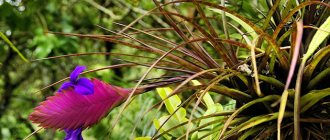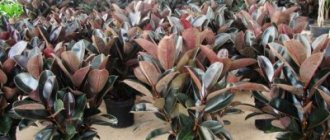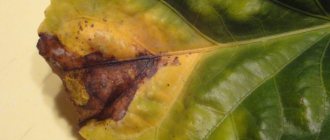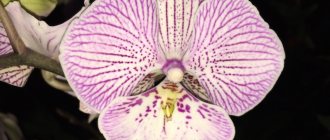But first, let's dot the i's. What amateur gardeners usually call gloxinia, and under the same name it is often sold in garden centers, is in fact not gloxinia at all - it is sinningia. True gloxinia also exist in nature, they are close relatives, and confusion occurred in the 19th century.
In 1785, botanists found a wonderful plant in the forests of Brazil, which was given the name Gloxinia maculata - in honor of the German doctor and naturalist Peter Gloksin. In 1815, another similar species was found in the tropical forests of Brazil. Its description was carried out by the then famous English gardener Conrad Loddigs - in 1917 he named the new plant Gloxinia speciose. And even later, in 1825, botanists found a third similar species, clearly related to the previous two, but its flower structure was different, and a tuber was discovered underground. And scientists decided to give it a different name - Sinningia, in honor of the chief specialist of the botanical garden of the University of Bonn, Wilhelm Sinning.
Subsequently, many other species were found, all of them were representatives of the Gesneriaceae family, all relatives, some were attributed to the genus Gloxinia, some to the genus Sinningia, and at some point it became obvious that they had gotten carried away with Gloxinia beautiful - it is more similar to Sinningia. In 1877, British botanist William Philip Hearn renamed Gloxinia splendor to Sinningia splendor.
But while botanists were studying the species and understanding the classification, breeders developed many forms and varieties based on that very beautiful Gloxinia - both they and flower growers really liked it. Of course, it also went on sale under the name “gloxinia”. Literally in the same 1817, the English magazine Curtis's Botanical Magazine (volume 44) wrote that this species “could be found in the largest collections of London.” And in 1818, the English botanist and gardener Robert Sweet included Gloxinia beautiful in the “Catalog of plants grown in the vicinity of London.” Every year more and more new varieties appeared, each of them causing a real stir. The plant was so loved by the British that British travelers even took it with them on ships. In 1822, the first Gloxinia arrived on the island of Mauritius. In 1839 she ended up in Bombay, India. In 1843 - to Calcutta, in 1851 - to the Virgin Islands, in 1955 - to Ceylon.
In general, by the time scientists realized that this lovely flower was not gloxinia, but sinningia, it had already spread throughout the world and the original name was firmly attached to it and is still preserved.
Botanical description and history
Beautiful Sinningia is known to amateur gardeners under the name Gloxinia . This is a tropical tuberous plant with bell-shaped, velvety, large, brightly colored flowers. Gloxinia has a straight stem, fleecy leaves, and solitary flowers.
Attention : The shades of gloxinia are very diverse. Flowers can be monochromatic, combined with white, have spots, streaks, borders, and shimmer in the bright sun. The flower has a ring nectary and four stamens.
In nature, this plant can be found in Brazil, America, and Mexico. It grows on rocks near the river, in tennis forest thickets. Gloxinia is grown in greenhouses and at home.
The flower belongs to the Gesneriaceae family. It was first found in Brazilian forests in 1785. It is South and Central America that is considered the birthplace of this plant. Boston University scientist V. Sinning has developed many hybrids of this plant, including the very popular Gloxinia rosea. In honor of this breeder, gloxinia received its second name - Sinningia .
Home care rules
Due to the nature of the plant during periods of growth and dormancy, it is necessary to maintain an optimal temperature. In summer, temperatures from 20 to 22 degrees Celsius during the day will be considered normal, and up to 18 degrees Celsius at night. In winter, the temperature should be maintained between 10 and 14 degrees.
Avoid drafts or temperature changes, as the plant may rot . For normal growth and good development, the humidity in the room must be maintained at approximately 70-80 percent.
Do not get water on flowers or foliage. Since gloxinia cannot be sprayed, the air must be humidified. To do this, you need to place the pot on pebbles or expanded clay. When the lump of earth dries out, then it should be watered.
Excess water leads to the death of the plant . Watering should be done with settled water, the temperature should be slightly lower than in the room. This process reduces the risk of root rot. For Gloxinia Sonata, it is necessary to regularly feed fertilizers. Feed four times a month from April to August. During the dormant period there is no need to feed.
Watch a video about caring for gloxinia at home:
Varieties and their photos
Fairy tale
Gloxinia called pink fairy tale blooms with gorgeous large velvet pink flowers. The center of the petals is crimson, the neck is light, strewn with dark specks.
Extravaganza
A variety of gloxinia called extravaganza also has large velvety flowers with a bright pink border and specks along the edges of the petals. The peduncles of Gloxinia extravaganza are short, pink-coral in color. As the buds bloom, they increase in size.
Dream
Gloxinia variety pink dream is a miniature flower with bright, elegant pink flowers . This flower has an elongated tube and a light-colored neck. The Pink Dream variety has a long flowering period.
Description of appearance and features
Pink Gloxinia is a tuberous plant with beautiful flowers. The thickened stems of gloxinia grow up to 10 cm in height; 4-6 pairs of leaves with opposite arrangement grow on the plant.
The leaves are oval, wide, heart-shaped at the base, velvety, 15 to 20 cm long. The veins of the upper part of the leaf are silvery, the lower part of the leaf has a reddish tint. The flowers of pink gloxinia are bell-shaped, velvety, on long peduncles .
Important : Growing gloxinia is not difficult, it is not picky about the soil, it reproduces easily and blooms profusely.
Gloxinia signs. Gloxinia - a talisman of love
Flower growers know that the appearance of gloxinia in the house has a positive effect on the family atmosphere. Superstitions associated with this plant have been formed over a long period of time. Further in the article we will look at some nuances that will help increase the powers of the miraculous flower.
What types of flowers do Gloxinia have?
It is especially interesting to observe the plant during the flowering period. Flowers can be of completely different shades: pink, purple, snow-white. There are both single-color and combined colors. The combination of white with purple or burgundy looks beautiful (photo).
During the flowering period, up to 20 buds can appear on one plant. Blooming bell-shaped flowers can be regular or double, with simple or wavy petals. The plant reaches a height of 30 cm.
Attention! You can admire the indescribable beauty of gloxinia from April to August.
What does Feng Shui say?
Each plant should have its own place in the house. According to the teachings of Feng Shui, correctly placed flowers can fill a space with positive Qi energy.
It is necessary to clarify which element the plant and household members belong to. Of course, all family members and the flower cannot fit into the same element. If it turns out that there is not a single representative of a suitable element (Earth) in the house, it is better to place the green assistant in a corner. He will delight you with his beauty.
Advice! For love and happiness, the plant should be placed in the southwest of the apartment (house), for children - in the east or in the children's room.
In the language of flowers, created in the 18th century by Charles II, gloxinia translates as “love at first sight.”
Important! The plant is most compatible with Taurus. They are distinguished by their closeness to the earth and material spheres. Gloxinia helps this sign achieve financial stability, as well as maintain vitality and health.
However, it also imparts energy and well-being to representatives of other zodiac signs.
What Gloxinia will bring into the house: signs
According to popular beliefs, gloxinia brings comfort, warmth to the home, and helps to improve relationships. Gloxinia is considered a talisman of love. During flowering, it literally fills the space with energy, which helps closed and uncommunicative people.
Esotericists advise the flower to indecisive people; they will be able to “burn bridges” and start living from scratch. The plant has a positive effect only during the flowering period. The plant brings love, happiness, and good luck in all areas to the home and family. It is flowers that are a sign, an excellent omen.
When the above-ground part dies, the energy field will rest.
Important! By placing a couple of bushes in the children's room, mothers will be able to calm their baby down. The child will be more obedient and flexible without unnecessary convincing.
What shade of flowers is better to choose?
Each flower has a certain bioenergy, the presence of which is scientifically proven! Gloxinia is not a pronounced donor or vampire, but she still has an influence on those around her. The shade of a plant can tell a lot:
- Purple helps avoid minor conflicts, absorbs negativity and brings peace.
- White flowers are ideal for any home. They bring good luck and cleanse the atmosphere of negativity and gloomy thoughts. They are especially useful in families with small children, since white is a symbol of new life and helps the younger generation.
- Pink or red color helps to distract from material and everyday problems. It will allow you to pay attention to the spiritual principle, direct your thoughts to issues of morality and morality.
- Blue flowers are recommended for creative people. They will give you inspiration and help you open new horizons, including acquiring new hobbies.
For many gardeners, gloxinia has already become one of their most favorite plants.
Important! The plant will not just be a beautiful decoration for your home, it will bring happiness, harmony and love to every home.
Thanks to the variety of shades, you can create a bright accent in the interior and create a real flower garden on the windowsill.
Where and how to plant it: rules and tips, instructions
When purchasing gloxinia tubers, you should pay attention to their size and appearance. They should be hard, 3-4 cm in size, without traces of mold or rot. In the upper part of the gloxinia tuber there is a depression where a bud is located, which looks like a tubercle.
Gloxinia is planted at a time when the tubers wake up after winter dormancy . This can be seen by the sprouts that appear. Most often this happens in February or March. You should not wait until the sprout grows large; you should plant a slightly sprouted tuber.
If the tuber is slightly damaged, then the damaged area should be cut out and sprinkled with charcoal, and the cut should be treated with a mixture of fungicide and root. After this procedure, it should be dried.
Rules for planting gloxinia:
Place a layer of drainage up to 2 cm high at the bottom of the pot. This can be expanded clay or polystyrene foam. Sprinkle soil on top without compacting it.- Make a hole in the center of the pot, place the tuber in it and sprinkle 2/3 of it with soil. The soil needs to be watered, but so that water does not get on the sprouts and in the center of the tuber, otherwise this may lead to rotting of the plant.
- To create the necessary microclimate, the pot is covered with polyethylene and placed in a warm, well-lit place - this helps create a greenhouse effect.
- Every day the pot is opened for 10-15 minutes to ventilate the plant. After the first leaves appear, the flower is covered only at night, and after a few days the polyethylene is removed altogether.
- As the stem grows, the tuber should be sprinkled with 1-2 cm of soil so that it remains in the ground and does not deteriorate.
- At first, you should water the plant little by little and carefully so that the tuber does not rot.
Lighting and location
Gloxinia loves good and even lighting because it has the peculiarity of reaching for light. However, direct sunlight can cause burns on the leaves of the plant, so the light should be diffused. In spring, gloxinia can stand on the sunny side, but when hot weather sets in, the plant should be shaded a little.
The best place for pink gloxinia is a rack and artificial lighting. In such conditions, gloxinia are protected from drafts and receive the required amount of light. The rosettes grow neat and the leaves are juicy.
Soil requirements
Indoor gloxinia is not very picky about the composition of the soil. The substrate for pink gloxinia tubers should be light, loose, nutritious, it should absorb moisture well and be permeable to air. Peat-based soil is suitable for such purposes.
A substrate that is too dense can retain moisture, and the flower will rot and die . For gloxinia, soil for flowering plants is suitable, to which you should add a couple of handfuls of sand and two tablespoons of vermiculite per liter of soil mixture. You can also prepare the soil yourself. To do this, mix leaf soil, sand and peat in a ratio of 2/2/1.
Advice : Before planting tubers in the soil mixture, it must be calcined in the oven or sprayed with the “Maxim” preparation in a proportion of 2 ml per liter of water and allowed to dry.
Origin of Sinningia
This flower plant is native to Brazil. The main habitat of Sinningia is in the monsoon tropical forests of this country. A peculiarity of growth in such conditions is the alternation of rainy periods with dry ones, during which the plant plunges into a peculiar state of dormancy.
This plant was cultivated only at the beginning of the 19th century, when it became widespread among flower lovers and received the name gloxinia. However, this name later turned out to be erroneous. The correct name for this flower plant is Sinningia, and Gloxinia would be the correct name for various hybrids that differ in color and corolla.
How to properly care?
Pink gloxinia is a non-capricious plant and very grateful . In order for her to feel comfortable, you need to follow simple rules:
Water with warm, settled water.- In order not to over-water the plant and not get water on the leaves and flowers, it is advisable to water it in a tray.
- To provide gloxinia with the necessary air humidity, the flower pot can be placed in a special tray filled with wet expanded clay.
- During the period of active growth (April-September), the plant must be fed with complex liquid fertilizers.
- When flowering ends, gloxinia is prepared for a period of rest. To do this, cut off the above-ground part of the plant, leaving a stump 2 cm high, and put the pot in a dark, cool place.
- At the end of February, the tubers are transplanted into new soil, having cleared of the old soil, cutting off their rotten parts and disinfecting the cuts.
Under favorable conditions, gloxinia can throw out up to twenty buds at the same time.
Gloxinia care
For all its decorativeness, caring for gloxinia is not too difficult. A little more attention will be needed during flowering, but at rest it will not cause much trouble.
Temperature
During the flowering season, gloxinia feels great at normal room temperature. But in winter, it definitely needs a coolness of about 10 degrees so that the flower goes dormant and gains strength before a new growth phase. If the leaves droop down, the gloxinia is too cold, and if they stretch upward too much, it is too hot.
Photo: nn.ru
Lighting
Gloxinia needs bright light and more free space around, and the minimum length of daylight for its growth is 12 hours. So if you live on the north side, take care of the phytolamp in advance. Be sure to avoid drafts and aggressive direct sunlight.
Photo: stocvetov.ru
Watering
To water gloxinia, you need well-settled and ideally filtered water at room temperature. Water the flowerpot when the top layer dries out to prevent the roots from rotting. Reduce the frequency closer to the end of the flowering period to smoothly transition the plant into the dormant stage.
Although gloxinia loves moisture, it cannot be sprayed or washed, otherwise the leaves and flowers will begin to deteriorate. Therefore, just use a humidifier or place a bowl of water on the windowsill near the flowerpots. For the same reason, experienced gardeners recommend using bottom watering during flowering.
Photo: senior-gardening.com
The soil
The similarity with violets and begonias is also evident in the choice of soil. Feel free to use specialized mixtures specifically for gloxinia. Or add half the amount of humus and sand to the deciduous soil.
Photo: domashniecvety.ru
Fertilizers and fertilizing
After the gloxinia has finished flowering, add some amendments to the soil for growth. After the buds appear, you need regular fertilizers for flowering, like violets. If gloxinia has enough nutrients, it can even bloom twice, just the second time - more sparingly.
In the active phase, feed the flower once every 10-14 days until mid-August. Mixtures with boron are definitely needed, otherwise the buds become smaller, and the leaves become as if frayed, with a cut edge.
Photo: pocvetam.ru
Care after flowering
When the gloxinia fades, cut off the stem and upper leaves, leaving only the bottom layer. Reduce watering and fertilizing until the plates turn yellow and dry out on their own. New buds will appear in their axils, of which only a couple of the strongest ones should be left, and the rest should be trimmed to stumps 1-1.5 cm high.
Photo: domashniecvety.ru
Transplantation and propagation
The easiest and most effective way to propagate gloxinia is through leaf cuttings. Moreover, you will not need the largest and most beautiful leaf, but, on the contrary, a small and inconspicuous one. A large plate will have to be divided into parts parallel to the transverse veins and the petiole cut to 1.5-2 cm.
The leaves do not need to be placed in water - immediately root them in a moist substrate in separate flowerpots. Build a small greenhouse on top or cover the flowers with a plastic bag. Without touching anything for at least 4 weeks - the seedlings do not need to be watered or ventilated separately. After this, gradually transfer them to normal mode and remove the shelter.
Gloxinia is replanted annually when the bush comes out of dormancy at the end of winter. This is done by transferring it together with a lump of earth so as not to damage the root system. The new pot should be slightly larger than the old one to renew the drainage and top layer of substrate.
Photo: domashniecvety.ru
Dracaena: home care, propagation and transplantation
Common diseases and pests
If not properly cared for, gloxinia may become sick or be affected by certain pests.
- Watering with cold water may cause brown spots to appear on the leaves.
- If there is an overdose of fertilizers or dry or too humid air, the leaves may turn yellow.
- A sign of the presence of powdery mildew or gray rot can be a gray coating on flowers and leaves.
To save the plant, you should remove damaged leaves and flowers, moderate watering, and treat the flower with a fungicide.
If gloxinia does not bloom, then add lighting to it and increase fertilizing with a minimum amount of nitrogen . Elongated pale green leaves can also indicate a lack of light.
Among the parasites that affect Gloxinia rosea are scale insects, whiteflies, spider mites, and mealybugs.
Transfer rules
Sinningia is replanted in early spring; the procedure can be combined with dividing the tuber. If wrinkled areas or dark spots appear on the surface, they should be trimmed and treated with a fungicide solution. Choose a small pot with holes in the bottom.
The soil for syningia should consist of the following components:
- leaf soil (3 parts);
- peat (2 parts);
- sand (1 part).
Expanded clay or clay shards are poured onto the bottom. A third of the tuber should remain on the surface.
Features of reproduction
Pink gloxinia propagates in several ways: tubers, leaf cuttings and seeds . Let's look at them.
Tubers
For division, a very overgrown tuber is taken. Using a sharp knife, it is cut into pieces so that each has a sprout. The cut area is sprinkled with activated carbon.
Parts of the tuber are planted in separate pots with moist soil . For the first 2-3 days after planting, the substrate is not moistened.
Watch a video about dividing a gloxinia tuber:
Leaf cuttings
When propagating by leaf cuttings, a young healthy leaf with a part of the cutting 1 cm long is cut off from a flowering plant. The cutting is rooted in a mixture of sand and peat in a ratio of 4/0.5. Cover the cuttings with a glass jar and maintain the temperature at 22-24 degrees.
Young nodules appear after 20 days . After this, the cuttings can be planted in separate containers.
Watch a video about propagating gloxinia using leaves:
Seeds
Gloxinia should be sown in November-February in wide, low containers filled with a substrate made from equal parts of peat soil, leaf soil and sand. Sow the seeds sparsely and shallowly, lightly sprinkled with soil.
The container is placed in a bright place where the temperature is maintained at 25 degrees. Periodically, the soil should be sprayed with warm water. Gloxinia begins to sprout after 12-14 days.
Plants are planted when two leaves form on them , at a distance of 2 cm from one another. Plants are planted in different pots when their leaves begin to touch each other.
Watch a video about propagating gloxinia by seeds:
Gloxinia rosea is undoubtedly a beautiful flower that can decorate any home. However, there are other, no less delightful species and varieties of gloxinia, you can learn more about them from the following publications:
- How to properly breed hybrid gloxinia at home?
- Terry gloxinia Yesenia: description of the flower and the care it needs.
- How to care for and propagate Gloxinia Rosalinda at home?
- White terry gloxinia is a beautiful and delicate flower in your home.
- Description of Gloxinia Brokada, tips for planting and propagating the flower.
- How to grow decorative gloxinia Sonata at home?
- Detailed description and characteristics of gloxinia varieties Kaiser Wilhelm and Friedrich.
- Description and features of growing varieties Krasnoyar'e and Red Riding Hood.
- One of the most beautiful varieties is Gloxinia Shagane.
Gloxinia – photo
Gloxinia is a very colorful flower that can transform and enliven any room. Just look at this photo selection!
Photo: dekormyhome.ru
Photo: 2sotki.ru
Photo: koffkindom.ru
Photo: 2sotki.ru
Photo: pinterest.at
Photo: plantasonya.com.br
Photo: pinterest.com.au
Photo: izhevsk.ru
Photo: uz.pastureone.com
Photo: nn.ru
Photo: ozelenitely.com
Photo: nanabe.ru
Photo: komnatnyecvety.ru
Photo: glosi.ru
Photo: pic2.me
Photo: sovetik-sad.ru
Photo: 2sotki.ru
Photo: zen.yandex.ru
Photo: 2sotki.ru
Photo: cvetkoffandbuketoff.ru
Photo: albinos76.livejournal.com
Photo: everything.kz
Photo: pinterest.com.mx
Photo: 2sotki.ru
Photo: bugaeva-flowers.ru
Geranium: home care, propagation and transplantation
